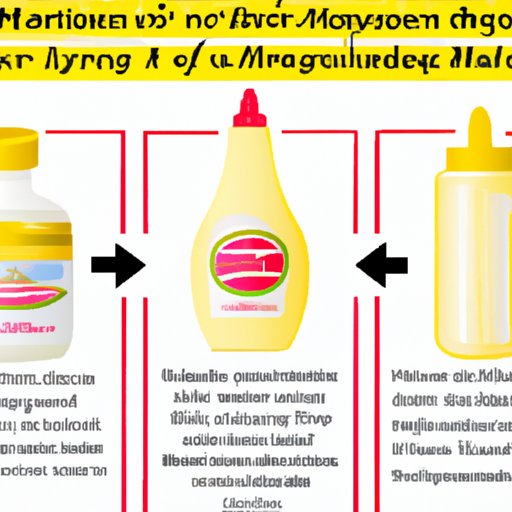Introduction
Light mayonnaise has become increasingly popular in recent years as people look for healthier alternatives to traditional mayonnaise. But what exactly is light mayo, and is it actually a healthier choice? In this article, we’ll explore the nutritional benefits and risks of light mayonnaise so that you can make an informed decision when it comes to choosing a healthier option.
Comparing Light Mayo to Regular Mayo: Nutritional Benefits and Risks
Light mayonnaise is typically made with fewer calories than regular mayonnaise, but it still contains many of the same ingredients, including oil, egg yolks, vinegar, and mustard. The main difference between light mayonnaise and regular mayonnaise lies in the types of oils used. Whereas regular mayonnaise typically uses a combination of vegetable and olive oils, light mayonnaise often contains primarily canola or soybean oil. Some brands also use nonfat yogurt or egg whites to reduce the fat content.
Nutritional Content
The nutritional content of light mayonnaise varies depending on the brand and type, but it generally contains fewer calories, fat, and cholesterol than regular mayonnaise. For example, one tablespoon (14 grams) of light mayonnaise typically contains 35–45 calories, 2–4 grams of fat, and 0–2 milligrams of cholesterol, compared to 95 calories, 10 grams of fat, and 25 milligrams of cholesterol in regular mayonnaise.
Health Benefits
Light mayonnaise is a good source of monounsaturated and polyunsaturated fats, which are important for heart health. It also contains some essential vitamins and minerals, such as vitamin E and potassium. Additionally, the lower calorie and fat content makes it a better choice for those trying to lose weight or maintain a healthy weight.
Potential Risks
Although light mayonnaise is lower in calories and fat than regular mayonnaise, it still contains a significant amount of sodium. Consuming too much sodium can increase your risk of high blood pressure, stroke, and other health problems. Additionally, some brands may contain artificial ingredients or added sugars, which can be unhealthy if consumed in large quantities.
Is Light Mayo a Healthy Choice? An Analysis of its Nutritional Profile
When considering whether light mayonnaise is a healthy choice, it’s important to take a closer look at its nutritional profile. Here’s an overview of the macronutrients, vitamins, and minerals found in light mayonnaise.
Macronutrient Breakdown
Light mayonnaise is low in carbohydrates and protein, but it does contain a moderate amount of fat. One tablespoon (14 grams) typically contains 2–4 grams of fat, 0–1 gram of carbohydrates, and 0–1 gram of protein.
Vitamins and Minerals
Light mayonnaise is a good source of several essential vitamins and minerals. It contains small amounts of vitamin E, potassium, magnesium, and iron. It also provides trace amounts of other vitamins and minerals, such as folate, calcium, and zinc.

How to Make the Healthiest Choices When Shopping for Mayonnaise
When shopping for light mayonnaise, it’s important to check the labels carefully. Here are a few tips to help you make the healthiest choices.
Checking Labels
Look for products that are low in sodium and free of artificial ingredients and added sugars. Check the ingredient list to make sure the product contains only natural oils, such as olive, canola, or soybean oil.
Avoiding Artificial Ingredients
Some brands of light mayonnaise contain artificial preservatives, flavorings, or colorings. These ingredients are not necessary and can be unhealthy if consumed in large quantities.
Looking for Healthy Oils
When shopping for light mayonnaise, look for products that contain healthy oils, such as olive, canola, or soybean oil. These oils are rich in monounsaturated and polyunsaturated fats, which are important for heart health.

Understanding the Difference Between Light and Regular Mayo
In addition to the nutritional differences between light mayonnaise and regular mayonnaise, there are also some differences in texture, taste, and ingredients. Here’s a brief overview of the key differences.
Ingredients
Regular mayonnaise is typically made with a combination of vegetable and olive oils, while light mayonnaise usually contains primarily canola or soybean oil. Some brands also use nonfat yogurt or egg whites to reduce the fat content.
Texture
Light mayonnaise is thinner and less creamy than regular mayonnaise. This is due to the fact that it contains less fat and more water.
Taste
Light mayonnaise has a milder flavor than regular mayonnaise. This is because it contains less fat, which gives it a lighter texture and a less intense flavor.

A Guide to Eating Healthily with Light Mayo
Light mayonnaise can be part of a healthy diet if consumed in moderation. Here are a few tips for making the most of this condiment.
Moderation
Light mayonnaise should be consumed in moderation. Even though it’s lower in calories and fat than regular mayonnaise, it still contains a significant amount of sodium and other unhealthy ingredients, such as added sugars. Therefore, it’s best to limit your consumption of light mayonnaise.
Portion Control
Be mindful of portion sizes when using light mayonnaise. While one tablespoon (14 grams) is generally considered a single serving, it’s easy to go overboard when adding condiments to sandwiches or salads. To avoid consuming too much, measure out the appropriate portion size before adding it to your meal.
Substituting Healthy Alternatives
If you’re looking for a healthier alternative to light mayonnaise, consider using avocado or hummus as a spread. Both are high in healthy fats and provide a delicious flavor without all of the unhealthy additives found in light mayonnaise.
Exploring the Pros and Cons of Eating Light Mayo
When it comes to eating light mayonnaise, there are both pros and cons. Here’s a closer look at the potential benefits and drawbacks of this condiment.
Pros
Light mayonnaise is lower in calories and fat than regular mayonnaise, making it a better choice for those trying to lose or maintain their weight. It also contains some essential vitamins and minerals, such as vitamin E and potassium. Finally, it’s a good source of monounsaturated and polyunsaturated fats, which are important for heart health.
Cons
Light mayonnaise contains a significant amount of sodium, which can increase your risk of high blood pressure and other health problems. Additionally, some brands may contain artificial ingredients or added sugars, which can be unhealthy if consumed in large quantities.
Conclusion
Light mayonnaise is a popular condiment that can be part of a healthy diet if consumed in moderation. It’s lower in calories and fat than regular mayonnaise, and it provides some essential vitamins and minerals. However, it’s important to be mindful of portion sizes and avoid brands that contain artificial ingredients or added sugars. By following these guidelines, you can enjoy light mayonnaise without compromising your health.
(Note: Is this article not meeting your expectations? Do you have knowledge or insights to share? Unlock new opportunities and expand your reach by joining our authors team. Click Registration to join us and share your expertise with our readers.)
